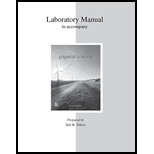
Concept explainers
The mass of Carbon-14 in
Answer to Problem 10PEB
Solution:
Explanation of Solution
Given data:
Mass of carbon-14 in the wood
Half-life of carbon-14
Age of the tree
Formula used:
the expression of number of half-lives iswritten as,
The expression of the mass after the half-lifeiswritten as,
Here,
Explanation:
Write the expression of number of half-lives.
Substitute
Since the number of half-life is 5, the mass will be divided 5 times.
The mass divided will be the mass of previous half-life divided by 2.
Write the expression of mass after the half-life.
Substitute
Write the expression of mass after the half-life.
Substitute
Write the expression of mass after the half-life.
Substitute
Write the expression of mass after the half-life.
Substitute
Write the expression of mass after the half-life.
Substitute
Conclusion:
The mass of carbon-14 is
Want to see more full solutions like this?
Chapter 21 Solutions
Lab Manual for Physical Science
- What is meant by the phrase geologic time?arrow_forwardIf the half-life of a radioactive specimen is 100 years, then how long will it take for the specimen to reach 25% of its original amount? (24.3) (a) 25 years (b) 50 years (c) 100 years (d) 200 yearsarrow_forwardHow do fossils aid in oil exploration?arrow_forward
- Why are so few fossils of worms found?arrow_forwardKEY TERMS 1. geologic time (Intro) 2. fossil (24.1) 3. paleontology 4. amber 5. replacement fossil 6. mold 7. cast 8. trace fossil 9. relative geologic time (24.2) 10. principle of original horizontality 11. principle of superposition 12. principle of cross-cutting relationships 13. unconformities 14. correlation 15. index fossils 16. eons 17. eras 18. periods 19. absolute (numerical) geologic time (24.3) 20. radiometric dating 21. carbon-14 dating 22. geologic time scale (24.5) 23. Cambrian explosion 24. Great Dying 25. epochs 26. K-T event For each of the following items, fill in the number of the appropriate Key Term from the preceding list. b. _____ The most devastating extinction that has ever occurredarrow_forwardSuppose that one species of index fossil lived between 410 and 380 mya and another lived between 440 and 350 mya. What can be said about the age of a rock that contains fossils of both species? Figure 24.22 Absolute Dating of Sedimentary Rocks See Exercise 7.arrow_forward
 An Introduction to Physical SciencePhysicsISBN:9781305079137Author:James Shipman, Jerry D. Wilson, Charles A. Higgins, Omar TorresPublisher:Cengage Learning
An Introduction to Physical SciencePhysicsISBN:9781305079137Author:James Shipman, Jerry D. Wilson, Charles A. Higgins, Omar TorresPublisher:Cengage Learning
